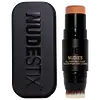What's inside
What's inside
 Key Ingredients
Key Ingredients

 Benefits
Benefits

 Concerns
Concerns

 Ingredients Side-by-side
Ingredients Side-by-side

Diisostearyl Malate
EmollientDimethicone
EmollientPolybutene
Caprylyl Methicone
Skin ConditioningVinyl Dimethicone/Methicone Silsesquioxane Crosspolymer
Synthetic Wax
AbrasivePolyethylene
AbrasiveBis-Diglyceryl Polyacyladipate-2
EmollientDimethicone/Vinyl Dimethicone Crosspolymer
Skin ConditioningKaolin
AbrasiveAluminum Starch Octenylsuccinate
AbsorbentC12-15 Alkyl Benzoate
AntimicrobialSilica
AbrasiveTocopheryl Acetate
AntioxidantCaprylyl Glycol
EmollientPhenoxyethanol
PreservativePentaerythrityl Tetra-Di-T-Butyl Hydroxyhydrocinnamate
AntioxidantHexylene Glycol
EmulsifyingCI 77891
Cosmetic ColorantCI 77491
Cosmetic ColorantCI 77492
Cosmetic ColorantCI 77499
Cosmetic ColorantDiisostearyl Malate, Dimethicone, Polybutene, Caprylyl Methicone, Vinyl Dimethicone/Methicone Silsesquioxane Crosspolymer, Synthetic Wax, Polyethylene, Bis-Diglyceryl Polyacyladipate-2, Dimethicone/Vinyl Dimethicone Crosspolymer, Kaolin, Aluminum Starch Octenylsuccinate, C12-15 Alkyl Benzoate, Silica, Tocopheryl Acetate, Caprylyl Glycol, Phenoxyethanol, Pentaerythrityl Tetra-Di-T-Butyl Hydroxyhydrocinnamate, Hexylene Glycol, CI 77891, CI 77491, CI 77492, CI 77499
Coco-Caprylate/Caprate
EmollientIsoamyl Laurate
EmollientSynthetic Wax
AbrasivePolymethyl Methacrylate
Silica
AbrasiveCaprylic/Capric Triglyceride
MaskingIsononyl Isononanoate
EmollientTriethylhexanoin
MaskingEthylhexyl Palmitate
EmollientPolyethylene
AbrasiveGlyceryl Caprylate
EmollientCamellia Sinensis Leaf Extract
AntimicrobialTocopherol
AntioxidantPhenoxyethanol
PreservativeMica
Cosmetic ColorantIron Oxides
CI 77891
Cosmetic ColorantCI 19140
Cosmetic ColorantCoco-Caprylate/Caprate, Isoamyl Laurate, Synthetic Wax, Polymethyl Methacrylate, Silica, Caprylic/Capric Triglyceride, Isononyl Isononanoate, Triethylhexanoin, Ethylhexyl Palmitate, Polyethylene, Glyceryl Caprylate, Camellia Sinensis Leaf Extract, Tocopherol, Phenoxyethanol, Mica, Iron Oxides, CI 77891, CI 19140
Ingredients Explained
These ingredients are found in both products.
Ingredients higher up in an ingredient list are typically present in a larger amount.
Ci 77891 is a white pigment from Titanium dioxide. It is naturally found in minerals such as rutile and ilmenite.
It's main function is to add a white color to cosmetics. It can also be mixed with other colors to create different shades.
Ci 77891 is commonly found in sunscreens due to its ability to block UV rays.
Learn more about CI 77891Phenoxyethanol is a preservative that has germicide, antimicrobial, and aromatic properties. Studies show that phenoxyethanol can prevent microbial growth. By itself, it has a scent that is similar to that of a rose.
It's often used in formulations along with Caprylyl Glycol to preserve the shelf life of products.
Polyethylene is a synthetic ingredient that helps the skin retain moisture. It is a polymer.
It is also typically used within product formulations to help bind solid ingredients together and thicken oil-based ingredients. When added to balms and emulsions, it helps increase the melting point temperature.
Silica, also known as silicon dioxide, is a naturally occurring mineral. It is used as a fine, spherical, and porous powder in cosmetics.
Though it has exfoliant properties, the function of silica varies depending on the product.
The unique structure of silica enhances the spreadability and adds smoothness, making it a great texture enhancer.
It is also used as an active carrier, emulsifier, and mattifier due to its ability to absorb excess oil.
In some products, tiny microneedles called spicules are made from silica or hydrolyzed sponge. When you rub them in, they lightly polish away dead skin layers and enhance the penetration of active ingredients.
Learn more about SilicaSynthetic Wax is created from fossil fuels such as natural gas. It is used to enhance texture, adjust pH, and as an occlusive.
It may also be used as an abrasive ingredient to exfoliate the skin.
Synthetic Wax may not be fungal acne safe.
Learn more about Synthetic Wax